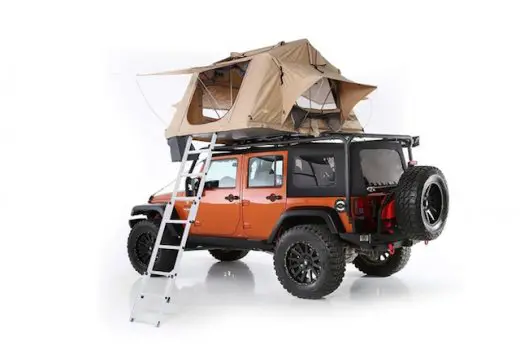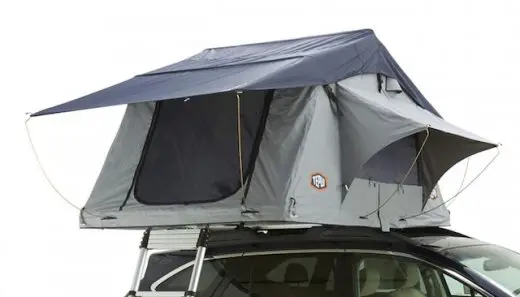
Fifty years ago, ground tent camping was one of the most common and popular types of camping.
However, there are a variety of other ways to camp today:
- In a hammock
- In a cabin
- In a bivvy bag
- In a rooftop tent
Rooftop tent camping involves setting up a tent on the roof rack above your car and sleeping in that tent every night.
There are several pros and cons to rooftop camping.
The main benefit of rooftop camping is that it raises you high above the ground, protecting you from wild creatures and allowing for more comfort than other types of camping.
However, to set up a rooftop tent, you need a specific type of vehicle. And even then, rooftop tents may impact your car’s aerodynamic function. They are also more expensive than regular ground tents but are still less expensive than RVs and motorhomes.
To decide whether it’s worth investing in a rooftop tent and whether it’ll work best for you, take some time to understand more about rooftop tents and their pros and cons.
What Are Rooftop Tents?

Unlike other types of camping – like hammock camping and bivvy bag camping – rooftop tent camping is a more recent form of camping.
This form of camping has been used in Africa and Australia for the past fifty years because these areas have several predators, poisonous insects, and snakes that crawl over the ground. It’s only in the last few years that they’ve gained popularity in North America.
Based on that short explanation of their history, you’ve probably gleaned a basic idea of what rooftop tents are: rooftop tents are tents designed to sit on top of your car’s roof rack.
They typically have a foam mattress which make up their base and come with a foldable ladder which help you climb up to the roof of your car.
When you’re not using your rooftop tent, you can collapse it so that it sits compactly above your car. Other accessories you’ll need when you get a rooftop tent are tent poles, travel covers, a flysheet; most of these will be included when you buy a rooftop tent. Some rooftop tents even have interior lights!
More and more campers today are trying out rooftop tents for a variety of reasons. You may have seen them in your Instagram feed or watched as someone descended from one in the campground you were last at.
Should you give them a try? You’ll need to weigh the pros and cons to decide.
The Pros of Rooftop Tents

There are several advantages to rooftop tents that help build an argument that you should give them a try.
You’re at an elevated height
Being a few feet above the ground can dramatically change your whole camping experience.
First of all, you won’t be anxious about any creepy crawlies slithering across the ground – this may help you get a better night’s sleep. The fact that you’re off the ground will also shield you from dampness or condensation that the ground or grass collects overnight.
In addition to this, rooftop tents have better ventilation, as there are fewer obstructions to airflow. Many rooftop tents also have built-in skylights and windows to help improve ventilation.
Since you’re at an elevated height, you’ll also enjoy better, less obstructed views. Rooftop tent campers have also found that stargazing from their rooftop tent can be better than stargazing from the ground!
They’re more comfortable
Most rooftop tents come with built-in memory foam mattresses, which adapt to the shape of your body and makes for a more comfortable night’s sleep.
These mattresses are much better than sleeping bags and inflatable camp mattresses. They will make sure your spine isn’t misaligned through the night. Some brands also have additional mattress features like innerspring layers, anti-condensation mats, and removable covers. All of these will help keep the mattress in better shape and help you sleep better.
They’re easier to set up
Many rooftop tents are easier to set up than traditional ground tents.
Unlike ground tents, which have a complicated setup process, rooftop tents only have to be opened and secured with guy lines and poles.
Once the ladder is unfolded, and any flaps are opened up, you’re ready to camp for the night!
Of course, you may have to practice setting up your rooftop tent a few times to get comfortable with the mechanics. Still, once you have a little experience, it’ll be much quicker than setting up a ground tent.
In addition to this, you don’t need to look for smooth ground to set up your rooftop tents. You can camp anywhere your car can go – from open fields to hiking trailheads. Some people with rooftop tents have even been spotted camping overnight in Walmart parking lots!
But while you can technically camp wherever your car is parked, you should try to park in a space that is as level as possible. If your car is at an angle, you’ll be sleeping at an angle – that’s neither comfortable nor good for your spine.
They are very weather-resistant
Rooftop tents are made with waterproof material and are very weather-resistant.
When it’s raining, you can collapse your tent, and the outer shell will keep the mattress and any other accessories inside dry. Rooftop tents also fare well in light snowfalls and storms.
They’re more spacious
Most companies design rooftop tents to be more spacious than their on-ground counterparts. Many can comfortably fit two people, but some can fit more than that. They also have higher ceilings than other tents. So, if you tend to get claustrophobic in small tents, a rooftop tent may be the answer.
You’ll have more room in your car’s trunk
When you use a rooftop tent, it will remain on top of your car, even when you’re not using it. Because of this, you’ll have more room in your car for other camping essentials like food and spare changes of clothes.
The Cons of Rooftop Tents

While there are plenty of benefits to rooftop tent camping, there are some negatives you should be aware of as well.
They’re heavy and can negatively impact your car
Rooftop tents can weigh between 100-150 pounds. While that does not seem like too much, your car’s roof and rack are not designed to support heavy weights for extended periods – even if your vehicle is a bigger SUV or truck.
If you have a hatchback or sedan, you may not be able to use a rooftop tent at all, as they may not be able to bear the weight.
Keeping your tent on top of your car for a long time may impact your car’s suspension. When the suspension is firm, your car drives smoother. But when the suspension is not working correctly, your car can ride more roughly, drift, and steer out of control.
Because a rooftop tent places more pressure on the top of your car, the suspension can sag, which can be a safety concern.
Additionally, the extra weight can interfere with your car’s aerodynamics, or its ability to accelerate and brake. As there is excess weight pulling the car back, your vehicle has to expend more energy to move forward, which will increase its fuel consumption.
You can’t use them in spots that cars can’t access
One of the best experiences in the wild can be when you discover a spot that looks like no one’s ever been there before. However, these spots usually aren’t accessible by road; you’ll have to leave your car and tent behind and come back to them as evening approaches.
In these cases, hammock camping and bivvy bag camping are better as you can set them up in places a car can’t reach.
They’re expensive
Figuring out the mechanics of a tent that will sit on top of a car is no easy feat. Rooftop tents are built with an extensive collection of accessories. As such, they are more comfortable and convenient than many other forms of camping.
This convenience comes at a cost; rooftop tents usually have a hefty price tag of $1,000 to $3,000. If you’re not a regular camper, this is a heavy price to pay for a few nights in the wild.
Getting in and out of the tent can be a hassle
Having to climb and descend your ladder every time you want to get in or out of your rooftop tent may get cumbersome or annoying.
For instance, if you have knee or back problems, clambering up and down a ladder can be taxing.
But even if your body is healthy, you may find it hard to get down the ladder at night. This is especially true when you wake up in a haze, as you might forget that the ladder is there, leading to a nasty tumble.
This article is owned by Recapture Nature and was first published on December 14, 2019
Are Rooftop Tents Worth it?

With a better understanding of the pros and the cons of rooftop tents, you can now make a more informed decision on whether or not they’re worth your while. Think about what kind of camping you do and how you might use a rooftop tent.
Getting a rooftop tent is not worth it if:
- You’re not a regular camper. Imagine spending a thousand or more dollars on a tent that you only use once or twice a year. If you’re not a regular or enthusiastic camper, then it’s better to get a regular tent.
- You want to go camping off road. On the other hand, if you’re an experienced camper and want to explore areas that are not accessible by road, then a rooftop tent will be of no use.
- You don’t have the right car. If you’re using a small car, it’s likely that your car won’t be able to bear your tent’s weight or will get severely damaged by it.
However, if you have the right car and are planning to spend lots of time traveling across locations in your car, a rooftop tent is worth considering. Even if it is more expensive, it will assure your comfort, protection, and privacy, which are three essential elements of long term camping.
How to Decide If You Should Get a Rooftop Tent

If you are seriously considering getting a rooftop tent, then there are a few factors you should think about before putting your money down.
Do you have the right car?
SUVs and larger cars are the most suitable vehicles for pitching a rooftop tent.
If you have a smaller car, a rooftop tent may affect your car’s suspension and fuel consumption. That said, there are a few tents which have been specially designed to fit on top of sedan cars or hatchbacks – look at the weight your car can bear and decide whether you want to risk it.
Can your car’s rack take the weight?
Even if you have an SUV, it’s a good idea to calculate how much weight your vehicle can take.
Every car’s manual will come with a recommended Dynamic Weight Capacity (DWC), which is the amount of weight that a car’s rack can carry.
The DWC of a car is typically less than the car’s Static Weight Capacity (SWC), which is the amount of weight a car’s roof can take when it is not moving. As a car can take more weight if it’s stationary, you can technically hitch a heavier tent onto your rooftop if you’re not moving.
However, that’s not feasible or practical – it’s better to look at the DWC and ensure that the weight of the rooftop tent fits that. And don’t forget about factoring in the weight of the tent’s ladder and the weight of the people who will be sleeping in it to calculate the tent’s total weight.
Do you need to upgrade your rack?
Many larger cars have a built on rack, which is the railing on the top of the car’s roof that supports luggage or a rooftop tent. Even if your vehicle does have one, you should assess its quality to see whether it will be able to carry the rooftop tent.
You can also look at purchasing racks that have been designed specifically for rooftop tents. Popular brands include Rhino-rack and Prinsu.
Choosing the Right Rooftop Tent

There are different types of rooftop tents. The two main ones are.
- Softshell tents. As their name suggests, soft shell roof top tents are made with lighter material and are less expensive than their hardtop counterparts. A softshell tent can cost between $1000-2000. They are best when you’re camping in moderate temperatures and can be set up and taken down more quickly than hardtop tents.
- Hardtop tents. Hardtop tents can cost between $2000-5000, but are made out of sturdier material. So, they work better in rough climatic conditions like during snowfalls and extreme winds. However, you should note that bigger hardtop tents may more than one person to help install them due to their weight
As rooftop tents are relatively new in the market, there are only a few major brands that you can look to if you’re looking to buy a rooftop tent.
Some popular brands for softshell tents are Yakima SkyRise Tents, Smittybilt, and Tepui.
If you’re looking for a hardshell tent, look at brands like IKamper, Bigfoot, and Front Runner.
While some brands are cheaper, be prepared to shell out a fair amount of money when you decide to go with the rooftop camping route.
You may also have to spend on upgrading your car rack. Also, you need to be careful that you have a car that can bear the weight of the tent and not get damaged.
Remember that if you are planning on going hiking in places that a car can’t access, it’s better not to go with a different kind of tent.
Despite these drawbacks, there are many reasons you should seriously consider a rooftop tent.
This article is owned by Recapture Nature and was first published on December 14, 2019
They offer you better protection and are more weather resistant than other types of camping. They are also more comfortable, more spacious, and can be set up easily.
If you want to decide whether you should invest in a rooftop tent, you should test one out before making a purchase.
Some companies allow you to rent a rooftop tent for a fraction of their purchase cost. That way, you can test whether you prefer a rooftop tent or an on-ground tent and decide whether you should buy one or not.
If you do buy one, make sure you are getting your tent under warranty so that you can return or replace it if needed.
Final Thoughts
If you decide to take the plunge, you can be sure that you’ll have a more comfortable, protected camping experience. You’ll wake up to a beautiful view and – as a bonus – be able to join the Instagram tribe of rooftop tent campers!
This article is owned by Recapture Nature and was first published on December 14, 2019
If that sounds appealing to you, head to your nearest camping store to start exploring your rooftop camping options today.

